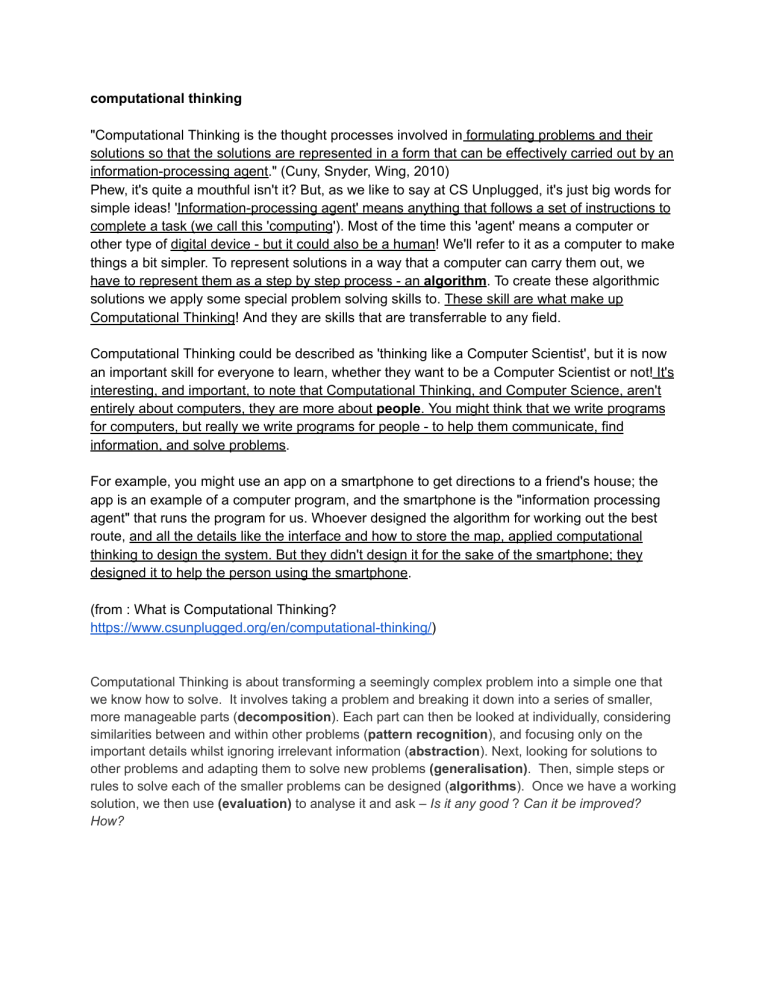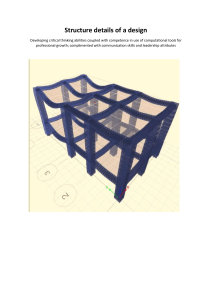
computational thinking "Computational Thinking is the thought processes involved in formulating problems and their solutions so that the solutions are represented in a form that can be effectively carried out by an information-processing agent." (Cuny, Snyder, Wing, 2010) Phew, it's quite a mouthful isn't it? But, as we like to say at CS Unplugged, it's just big words for simple ideas! 'Information-processing agent' means anything that follows a set of instructions to complete a task (we call this 'computing'). Most of the time this 'agent' means a computer or other type of digital device - but it could also be a human! We'll refer to it as a computer to make things a bit simpler. To represent solutions in a way that a computer can carry them out, we have to represent them as a step by step process - an algorithm. To create these algorithmic solutions we apply some special problem solving skills to. These skill are what make up Computational Thinking! And they are skills that are transferrable to any field. Computational Thinking could be described as 'thinking like a Computer Scientist', but it is now an important skill for everyone to learn, whether they want to be a Computer Scientist or not! It's interesting, and important, to note that Computational Thinking, and Computer Science, aren't entirely about computers, they are more about people. You might think that we write programs for computers, but really we write programs for people - to help them communicate, find information, and solve problems. For example, you might use an app on a smartphone to get directions to a friend's house; the app is an example of a computer program, and the smartphone is the "information processing agent" that runs the program for us. Whoever designed the algorithm for working out the best route, and all the details like the interface and how to store the map, applied computational thinking to design the system. But they didn't design it for the sake of the smartphone; they designed it to help the person using the smartphone. (from : What is Computational Thinking? https://www.csunplugged.org/en/computational-thinking/) Computational Thinking is about transforming a seemingly complex problem into a simple one that we know how to solve. It involves taking a problem and breaking it down into a series of smaller, more manageable parts (decomposition). Each part can then be looked at individually, considering similarities between and within other problems (pattern recognition), and focusing only on the important details whilst ignoring irrelevant information (abstraction). Next, looking for solutions to other problems and adapting them to solve new problems (generalisation). Then, simple steps or rules to solve each of the smaller problems can be designed (algorithms). Once we have a working solution, we then use (evaluation) to analyse it and ask – Is it any good ? Can it be improved? How? (from : “Developing Computational Thinking” https://www.icompute-uk.com/news/computational-thinking-2/ https://www.icompute-uk.com/news/wp-content/uploads/2016/02/icompute-computational-thinki ng-infographic-v2-1024x1024.png) Computational thinking is a problem solving process that includes a number of skills and techniques. It is one of the most fundamental skills for the future that can effectively and creatively solve problems like a computer scientist. Computational thinking can simplify tedious, time-consuming tasks! One important aspect of computational thinking is the ability to decompose a large problem into smaller, more manageable pieces. This makes it possible to solve complex problems by breaking them down into smaller, easier to solve sub-problems. Another key aspect is pattern recognition. By recognizing patterns in data, we can make better predictions and decisions. Computational thinking is not just for computer scientists! It is a valuable skill for everyone. With the world becoming increasingly digitized, those who are able to think computationally will have a definite advantage in many aspects of life. The good news is that computational thinking can be learned at any age! (from : What is Computational Thinking https://www.kidocode.com/blog/computational-thinking https://assets-global.website-files.com/61d6943d6b59241863c825d6/62cfafd590bc5b19d1d93e 10_CT%20(1).png) The idea computational thinking might even have been proposed before Papert when Naur (1970) used the Danish version of the term computational thinking (datalogisk tænkning)to describe analysis of data representations, data processing, data medias,etc. Relationship between CT and unplugged approach? Thus, human creativity and innovation is at the center and computing tools serve an ancillary role. While plugged tools play an important role in today’s highly digitized world and have remarkably expanded and enriched our toolboxes, we need to examine how unplugged activities support plugged activities given that humans are central in computing. To foster innovation and open solutions, mental human skills and understanding of the underlying principles of computing are required. Thereby, we argue that we need to combine unplugged and plugged approaches to engage students in computer science ideas. (...) Evidence is also starting to emerge that unplugged approach can be effective in developing computational thinking skills and helping students translate those skills into coding. (from : “Unplugged Approaches to Computational Thinking - a Historical Perspective” (2019) by Elisa Nadire Caeli1&Aman Yadav https://www.researchgate.net/publication/334280681_Unplugged_Approaches_to_Computation al_Thinking_a_Historical_Perspective) "Unplugged" Computational Thinking “Unplugged” computational thinking means working without a digital device. With unplugged activities, students must decompose a problem (break it down into manageable chunks) and sequence a solution (create instructions). This sequencing of instructions or steps creates an algorithm that others can follow or carry out. (from : “Unplugged Computational Thinking - what is it and how could you teach it” (2022) by Stephen Ross, Digital Technology Facilitator, Te Whai Toi Tangata, University of Waikato https://www.waikato.ac.nz/professionallearning/blog/unplugged-computational-thinking-what-is-it -and-how-could-you-teach-it) Computational thinking through unplugged activities


